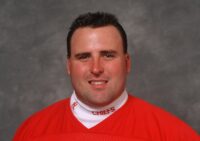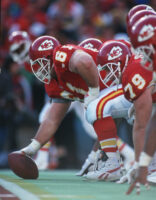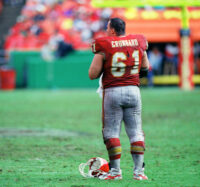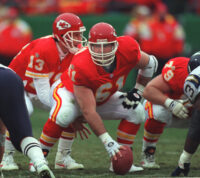Inductees
Tim Grunhard
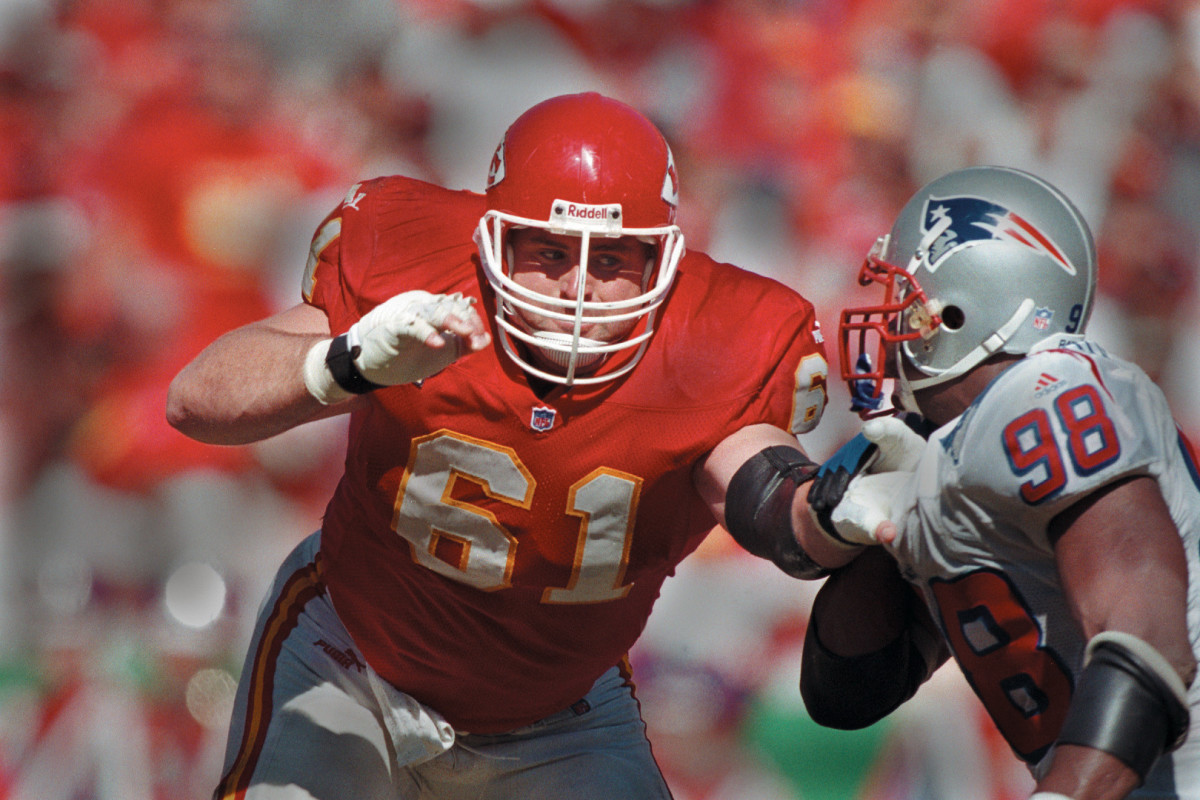
Born: May 17, 1968
Tim Grunhard laughs about it now. After all, he was just a rookie. But the first time he walked into the Kansas City Chiefs locker room, he assumed the “old guy” standing next to his locker was just another assistant coach.
Turns out, it was his mentor for his 1990 rookie season – future Hall of Fame center Mike Webster, set to retire at year’s end and ready to mold Grunhard into a National Football League center.
“He said, ‘Hey, kid. I’m too old to play, and I want to teach you how to play my position,’” Grunhard recalled. “I was very lucky to walk into a great situation.”
By the time Grunhard walked off the field 11 seasons later, he was one of the Chiefs’ all-time greats. Now his next step is the Missouri Sports Hall of Fame, which is proud to induct the Chiefs’ longtime center as part of the Class of 2016.
Selected 40th overall out of Notre Dame in the 1990 draft, Grunhard agreed to move to center – a position he had never played – and his transition helped to change the franchise’s narrative. The Chiefs reached the NFL playoffs seven times in the 1990s, including the AFC Championship game in January 1994.
Grunhard, who was voted to the All-Rookie team in 1990, played 169 games in the NFL, all as a member of the Chiefs, and earned a trip to the Pro Bowl in 2000. His 169 games played rank 13th all-time in team history, and he ranks fourth in games started (164) and consecutive starts (120) in Chiefs annals. Additionally, his 10 postseason career games played are tied for first in team history.
To Grunhard, his NFL success stems from Webster, the Chiefs organization and the passionate fanbase that made for a welcoming environment.
Even now, he can recall Webster’s sage advice.
“A lot of it was about effort — play as hard as you can, go 100 percent. That’s the way he did everything in life, even running to the line of scrimmage out of the huddle,” Grunhard said of Webster. “He would say, ‘If you want to keep a job, understand your offense as well as your coach. If you do that, they’ll keep you.’”
Grunhard’s arrival came after he was a four-year starter and All-American at Notre Dame, where he helped the Irish to a 24-1 record in his final two seasons and the 1988 NCAA championship.
His skills were perfect for the Chiefs’ 1990s of “Marty Ball” – so named after run-oriented coach Marty Schottenheimer, as Kansas City’s impressive line play plowed the field for feature back Marcus Allen and protected quarterback Joe Montana.
Alongside Grunhard were Dave Szott and Will Shields. Or, as Grunhard called it, “The Szott, Shields and Grunhard Law Firm,” for its ability to hold firm against defenders. “We were able to play a bunch of games together,” Grunhard said. “I don’t think with free agency that can happen anymore.”
The 1993 season was one of Grunhard’s favorites as the team reached the AFC Championship game. The Chiefs rallied to beat the Pittsburgh Steelers in their playoff opener and exacted revenge on the Houston Oilers the next week, winning 28-20 in the Astrodome. You may remember tight end Keith Cash’s early third quarter, rally-inspiring touchdown in which he celebrated by heaving the football at an oversized poster emblazoned with the likeness of Oilers coach Buddy Ryan.
“That was one of the most satisfying games I played in my career,” Grunhard said. “We had gone there early in the season and they whipped us 30-0 (without Montana). We came out the second half in the next game, made some adjustments and beat them.”
By then, Grunhard had become fully invested in Kansas City. In essence, it became home and still is. He is a football coach at nearby Bishop Miege High School.
Credit the all-around support from Chiefs fans in Kansas City and the Midwest for keeping Grunhard, a native of Chicago, in Chiefs country.
“The great thing about Kansas City is the love affair between the fans and the team. They are so into it, it’s kind of like college. They feel like they have a part,” Grunhard said. “And I was blessed to be a part of Kansas City with a great ownership and great coaches and great teammates.
“After football, my wife and I decided we wanted to stay in the Kansas City area because we liked the way the schools are set up. In 1990, when the phone rang on draft day and they said I had been taken by Kansas City in the second round, we laughed and said, ‘Where is Kansas City?’ Now we wouldn’t imagine living anywhere else.”
